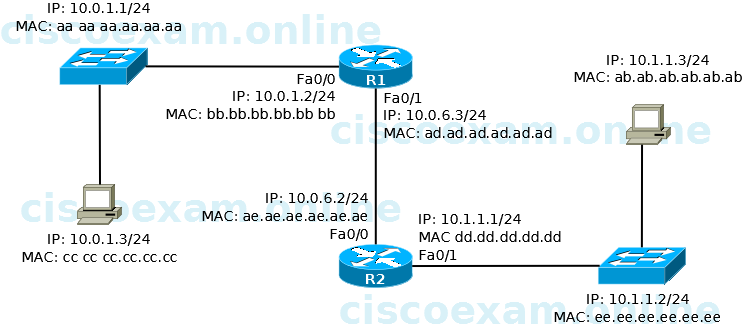The workstation at 10.0.1.3 sends a packet to the workstation at 10.1.1.3.

When the packet leaves the R2 router, what addresses will be located in the header?
| A. |
Source MAC bb.bb.bb.bb.bb.bb Dest MAC ab.ab.ab.ab.ab.ab | |
| B. |
Source MAC dd.dd.dd.dd.dd.dd Dest MAC ab.ab.ab.ab.ab.ab | |
| C. |
Source MAC ee.ee.ee.ee.ee.ee Dest MAC ab.ab.ab.ab.ab.ab | |
| D. |
Source IP 10.0.1.3 Dest IP 10.1.1.3 | |
| E. |
Source IP 10.0.1.1 Dest IP 10.1.1.2 | |
| F. |
Source IP 10.0.1.2 Dest IP 10.1.1.3 | |
| G. |
Source IP 10.0.1.1 Dest IP 10.1.1.3 |
When the packet leaves the R2 router, the addresses that will be located in the header are:
Source MAC dd.dd.dd.dd.dd.dd
Dest MAC ab.ab.ab.ab.ab.ab
Source IP 10.0.1.3
Dest IP 10.1.1.3
The router interface
(10.1.1.1/24) would use an ARP broadcast to determine the MAC address associated with the IP address 10.1.1.3/24 and it would be returned as ab.ab.ab.ab.ab. The router interface would then encapsulate the packet in a frame addressed to ab.ab.ab.ab.ab.
The source and destination IP address never change as the packet is routed across the network. The MAC address will change each time a router sends the packet to the next router or to the ultimate destination. The switches do not change either set of addresses in the header; they just switch the frame to the correct switch port according to the MAC address table. Therefore, when the packet leaves R2, the source MAC address will be that of R2, and the destination will be that of the workstation at 10.1.1.3. The IP addresses will be those of the two workstations, 10.0.1.3 and 10.1.1.3.
When the workstation at 10.0.1.3 starts the process, it will first determine that the destination address is in another subnet, and will send the packet to its default gateway at 10.0.1.2. It will perform an ARP broadcast for the MAC address that goes with 10.0.1.2, and R1 will respond with its MAC address, bb.bb.bb.bb.bb.bb.
After R2 determines the next-hop address to send to 10.0.1.3 by parsing the routing table, it will send the packet to R1 at 10.0.6.2. When R2 receives the packet, R2 will determine that the network 10.0.1.0/24 is directly connected and will perform an ARP broadcast for the MAC address that goes with 10.0.1.3. The workstation at 10.0.1.3 will respond with its MAC address, ab.ab.ab.ab.ab.ab.